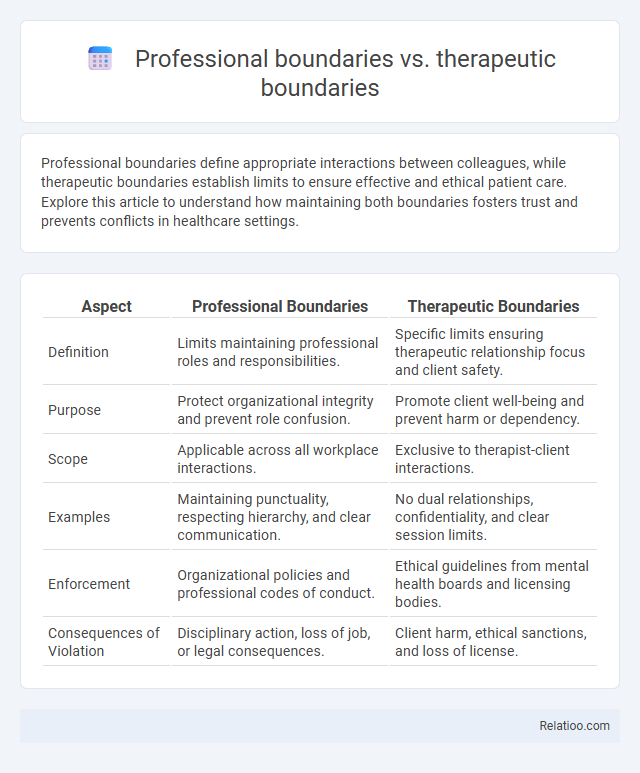Professional boundaries define appropriate interactions between colleagues, while therapeutic boundaries establish limits to ensure effective and ethical patient care. Explore this article to understand how maintaining both boundaries fosters trust and prevents conflicts in healthcare settings.
Table of Comparison
| Aspect | Professional Boundaries | Therapeutic Boundaries |
|---|---|---|
| Definition | Limits maintaining professional roles and responsibilities. | Specific limits ensuring therapeutic relationship focus and client safety. |
| Purpose | Protect organizational integrity and prevent role confusion. | Promote client well-being and prevent harm or dependency. |
| Scope | Applicable across all workplace interactions. | Exclusive to therapist-client interactions. |
| Examples | Maintaining punctuality, respecting hierarchy, and clear communication. | No dual relationships, confidentiality, and clear session limits. |
| Enforcement | Organizational policies and professional codes of conduct. | Ethical guidelines from mental health boards and licensing bodies. |
| Consequences of Violation | Disciplinary action, loss of job, or legal consequences. | Client harm, ethical sanctions, and loss of license. |
Defining Professional Boundaries
Professional boundaries define the limits that protect the integrity of your role, ensuring trust and respect within workplace relationships. Therapeutic boundaries specifically guide interactions between healthcare providers and patients, maintaining a safe, ethical therapeutic environment. Clear professional boundaries prevent conflicts of interest and preserve objectivity, fostering effective communication and accountability in your professional conduct.
Understanding Therapeutic Boundaries
Understanding therapeutic boundaries involves recognizing the specific limits set to protect the well-being of clients while maintaining a professional relationship. Therapeutic boundaries differentiate from general professional boundaries by focusing on the emotional and psychological safety unique to clinical or counseling settings. Clear therapeutic boundaries prevent dual relationships, ensure confidentiality, and promote trust essential for effective treatment and client progress.
Key Differences Between Professional and Therapeutic Boundaries
Professional boundaries define the ethical limits that maintain a respectful and appropriate relationship between you and your clients, ensuring that roles and responsibilities are clear. Therapeutic boundaries are a subset of professional boundaries specifically within clinical settings, focusing on preventing dual relationships, maintaining confidentiality, and fostering a safe environment for healing. The key difference lies in therapeutic boundaries' emphasis on emotional and psychological aspects, whereas professional boundaries apply broadly across all professional interactions.
The Importance of Maintaining Clear Boundaries
Maintaining clear boundaries is essential to preserve trust and effectiveness in therapeutic relationships, ensuring that professional interactions remain ethical and focused on client well-being. Professional boundaries define the appropriate limits of behavior and communication in workplace settings, while therapeutic boundaries specifically regulate the clinician-client dynamic to prevent conflicts of interest and emotional entanglement. Clear boundaries protect both parties from exploitation or harm and uphold the integrity of therapeutic interventions.
Common Boundary Challenges in Professional Settings
Common boundary challenges in professional settings often arise from confusion between professional boundaries, therapeutic boundaries, and general professional boundary concepts. Professional boundaries set clear limits to maintain appropriate relationships in any workplace, while therapeutic boundaries specifically safeguard the client-therapist relationship from over-involvement or dual relationships. Challenges include managing power dynamics, ensuring confidentiality, and avoiding favoritism or emotional entanglement, which can lead to ethical violations and compromised trust.
Navigating Boundary Issues in Therapeutic Relationships
Navigating boundary issues in therapeutic relationships requires a clear understanding of professional boundaries, therapeutic boundaries, and the specific concept of professional boundary maintenance. Professional boundaries set the ethical limits that protect both you and your clients, ensuring a safe and respectful environment, while therapeutic boundaries focus more directly on the emotional and psychological space necessary for effective treatment. Maintaining these boundaries prevents role confusion, protects confidentiality, and upholds the integrity of the therapeutic process, ensuring that the relationship remains focused on your client's well-being rather than personal or non-professional interactions.
Consequences of Boundary Violations
Violating professional boundaries can lead to loss of trust, legal repercussions, and damage to your reputation within the workplace. Therapeutic boundary violations often result in emotional harm to clients, compromised treatment outcomes, and potential ethical sanctions against practitioners. Understanding and maintaining clear professional boundaries is essential to prevent negative consequences such as client exploitation, confidentiality breaches, and professional misconduct allegations.
Strategies for Setting and Enforcing Boundaries
Strategies for setting and enforcing professional, therapeutic, and professional boundaries include clear communication, regular self-assessment, and consistent application of ethical guidelines. You can establish these boundaries by defining roles, maintaining confidentiality, and addressing boundary crossings promptly to protect both the client's well-being and the integrity of the professional relationship. Implementing training programs and supervision further supports boundary adherence and helps manage potential challenges effectively.
Ethical Guidelines for Boundary Management
Ethical guidelines for boundary management emphasize maintaining clear distinctions between professional boundaries, which define appropriate behavior and roles within any professional relationship, and therapeutic boundaries that specifically govern the clinician-patient dynamic to ensure trust and prevent exploitation. You must adhere to these guidelines to safeguard the therapeutic alliance, avoid conflicts of interest, and uphold confidentiality and respect within professional interactions. Effective boundary management involves ongoing self-awareness, supervision, and adherence to ethical codes such as those from the American Psychological Association or similar regulatory bodies.
Enhancing Awareness and Boundary Skills in Practice
Professional boundaries define the ethical limits within which practitioners operate to maintain respectful and effective relationships, while therapeutic boundaries specifically address the unique dynamics in client-provider interactions to safeguard emotional and psychological well-being. Enhancing awareness of these boundaries involves continuous training and reflective practice to recognize signs of boundary crossing or violation, thereby promoting ethical decision-making and client trust. Developing boundary skills in practice includes setting clear expectations, effective communication, and self-monitoring techniques that reinforce professionalism and protect both the practitioner and client.

Infographic: Professional boundaries vs Therapeutic boundaries
 relatioo.com
relatioo.com